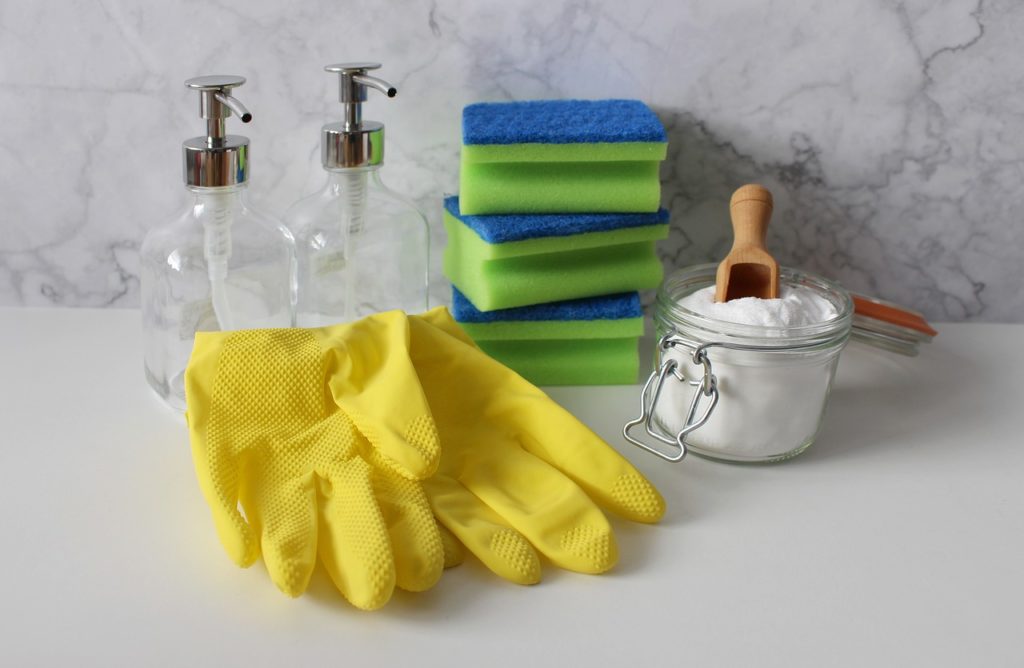In order to understand the benefits of green cleaning products in your home, it’s important to understand what exactly we mean by green cleaning. Green can be a bit of a buzzword nowadays, regrettably co-opted used by corporations who are anything but. When we’re talking about green products, we’re talking about products that are environmentally friendly. That means they’re friendly to your local environment – your home – and to the global environment. Fortunately, it just so happens that the products that are better for people are usually better for the planet, too – who’d have thought? According to fellow Canadian cleaning experts from Certified Green Cleaning “Choosing greener products…is better for both the environment and your personal health”.

Green Cleaning Protects Our Food and Water
What happens to your cleaning products when you’re done using them? Things like laundry detergent, dish soap, and all-purpose cleaners often end up getting flushed down the drain. Meanwhile, plastic bottles with cleaning product residuals end up in landfills, while window cleaner might end up draining into your yard.
The consequences of all of these chemicals ending up in our soil and groundwater are not yet clear; that’s in part because there are so many different chemicals mixing together in such varying amounts that it’s hard to know exactly what kind of chemical cocktails we have in which places. While most sewer systems can eliminate many household cleaners, doing so takes time and resources, and it may not help get rid of chemicals in groundwater. Chemicals like alkylphenol ethoxylates, which are used in many cleaners, are known to have serious health consequences to wildlife.
When you choose to clean green, you’re choosing to mitigate the use of chemicals that could have disastrous and unpredictable effects on our ecosystem.
It Protects Our Air, Too
You’ve probably heard the buzz around volatile organic compounds (VOCs). They’re everywhere, from cleaning products and cans of paint to air fresheners. VOC is a catch-all category for compounds that easily become vapors or gases; as you can imagine, that includes a lot of cleaning products.
VOCs come with a lot of problems, and we’ll look at more of them in the next part of this post, but the big problem for air quality comes from when they mix with nitrogen oxides (NOxs). NOxs are everywhere in our air; when something is burning (like coal in a power plant, or even cigarettes), you can bet there are NOxs forming. When certain VOCs and NOxs combine, they create ozone. When ozone is way up in the ozone layer, it’s beneficial, blocking some harmful UV rays. When it’s down on the ground, however, it becomes smog that can damage respiratory tissues.
When you’re looking for green products, look for cleaners with low to no VOCs. You can apply that philosophy to more than just green cleaning, too; you can find all kinds of low VOC products for your home once you know to look for them.
Your Body Will Thank You
We’ve talked a lot so far about how cleaning products can negatively affect the wider world; it will come as no surprise that those negative effects can harm you, too. VOCs are linked with a wide variety of medical problems, ranging from minor (irritation of the eyes and throat, mild allergic reactions) to very serious (liver, kidney, and nervous system problems). Some VOCs are even thought to contribute to cancer. While it’s important to remember that because VOCs are such a wide category of compounds that not all of them will have the same negative effects, the best line of defense is to reduce your exposure to them.
Cleveland Clinic has created a list of household products which contain chemicals that can be harmful, either through skin contact, inhalation, or ingestion. You may be astonished by the size of the list. It’s truly baffling to consider how many harmful products most people have in their homes at any given time, especially since green alternatives exist for many of the chemicals listed.
California just passed the Right to Know Act; this act requires manufacturers to alert consumers if their products contain any of thousands of different chemicals that could be harmful to the consumer’s health. There are so many different chemicals that instead of a list of chemicals, you’re presented with a list of lists; carcinogens, neurotoxicants, endocrine disruptors, and a whole host of other things you’d never want anywhere near your house. By consulting these lists, as well as the Cleveland Clinic list, you’ll get a better idea of the dangers presented by some cleaners you might have in your home. There are a wide variety of different ways a product might be designated green, but if you want to be fairly sure, check the ingredient list against the lists we’ve just discussed.
Your Wallet Will, Too
With all the doom and gloom we’ve been dwelling on so far, it can feel like green cleaning is a monumental chore; something you have to do, but that you might not want to do. Fortunately, the adjustment to green cleaning is rather simple, and often cost-effective. Green products on the market are usually about the same price as traditional cleaners. Better yet, you can often make your own green cleaning product; baking soda, essential oils, white vinegar, lemon juice, water, and other things you probably have around your house already can seriously up your green cleaning game, while only costing you pennies.
Consistent household cleaning is great for your health; at least, it should be. When you clean your space, you improve both your mental and physical well-being, but only if the products aren’t harming you in the long run. The better you feel, the more productive you can be; that means more money in your pocket, but it also means more time to spend with family, friends, or just reading a good book. Going green is an investment: in your pocketbook, in your family, in the planet, and in yourself.

